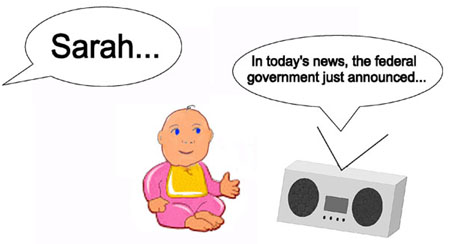Rochelle S. Newman - rnewman@hesp.umd.edu
Department of Hearing and Speech Sciences and
Program in Neurosciences and Cognitive Sciences
University of Maryland
College Park, MD 20742
Popular version of paper 3aSC2
Presented Wednesday Morning, April 30, 2003
145th ASA Meeting, Nashville, TN
|
Cars screeching across the
TV screen; siblings bickering in another room; the blender whirrs in the
kitchen; and somehow, in the midst of all the noise, an infant sifts the
sound of her own name out of the tumult and responds.
|
| Names were chosen because prior
research in quiet labs has shown that at 4.5 months, babies will listen
longer to their own name than to another name (Mandel, Jusczyk & Pisoni,
1995). We examined if this would hold true in a noisy environment. If infants
are not able to recognize speech in these settings, it would suggest that
infants who spend a significant amount of time in noisy settings such as
daycare centers, or in the presence of siblings, would be at a distinct
disadvantage for learning language. |
 |
|
In the second version of the experiment, the woman’s voice was only
5 decibels louder than the sounds of the background talker. (Examples
of these sounds are presented below.) Here, infants found the task much
harder; they did not appear to be able to distinguish their own name from
other names in this situation.
These results suggest that infants are much more sensitive to noise than
are adult listeners. Adults can understand speech when the voice they
are listening to is 8 dB softer than the background noise (Hawkins &
Stevens, 1950); yet infants were having difficulty when the target was
still louder than the background. Thus, infants are likely to have difficulty
listening in levels of noise that adults wouldn’t even think twice
about. This is particularly worrisome since daycare centers can often
have noise levels that even adult listeners find daunting.1 These results
imply that infants in day care settings are likely unable to distinguish
much of the speech spoken to them, and thus have fewer opportunities to
learn their native language.
|
|
Main references
|